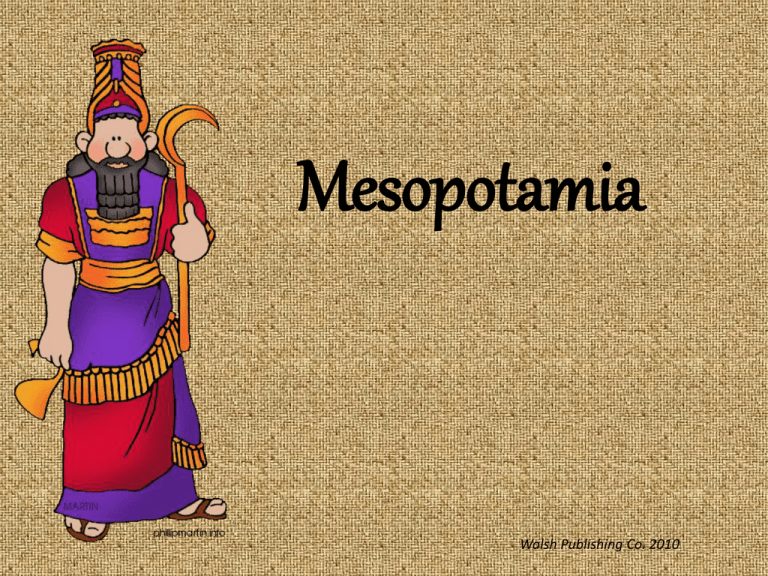Mesopotamia Walsh Publishing Co. 2010
advertisement

Mesopotamia Walsh Publishing Co. 2010 Mesopotamia Land Between Two Rivers Mesopotamia was known as the “Fertile Crescent” because of it’s crescent shape and availability of fertile or “rich” soil…good for planting. It was also known as the “Cradle of Civilization” because it was the birthplace of civilization…the first major civilization. Mesopotamia was located between the Tigris and Euphrates Rivers. The country of Iraq is there today. Walsh Publishing Co. 2010 Mesopotamia…the Land Dry, hot and desert-like outside of the river valley. The rivers would flood every Spring, leaving silt behind to help create fertile, rich soil which was great for growing! Mesopotamians made advancements in agriculture and domestication of animals. Walsh Publishing Co. 2010 Mesopotamia – City-States There were many city-states that developed in Mesopotamia. They each had their own government and leaders. Often times, they would fight wars over resources and land. Walsh Publishing Co. 2010 Development of Agriculture Important Inventions: The plow, the wheel/cart, irrigation systems. These inventions helped crops to grow which led to a surplus of food. The surplus let to a system of trading. Walsh Publishing Co. 2010 Development of Language – Cuneiform Writing Development of a language and system of writing: Cuneiform on clay tablets. Scribes were people that could read and write the language. Walsh Publishing Co. 2010 Buildings in Mesopotamia Mud-brick houses, reed huts and ziggurats at the center of the city Walsh Publishing Co. 2010 Ziggurat – Temple for the Gods Mesopotamians were polytheistic which means they believed in many gods. Walsh Publishing Co. 2010 Development of Laws – The Code of Hammurabi A civilization needs laws. The first set of written laws that we know about is called the “Code of Hammurabi.” King Hammurabi came up with a set of laws for his people to follow. The rules had very strict and harsh consequences. The laws became known as the “Eye for an Eye” laws because the consequence would often fit the crime. Walsh Publishing Co. 2010 Social Classes and Division of Labor • People started specializing or becoming trained in different jobs. There were farmers, craftsmen, priests, merchants, soldiers, scribes, rulers and slaves. People had different jobs to do and contributed to the society. • Depending on their wealth and education, people were valued differently and were treated differently by the law. Slaves and peasants were at the bottom of the social pyramid and rulers, priests and the wealthy were at the top. Walsh Publishing Co. 2010 Contributions of Mesopotamia calendar cobblestone streets cultivation of grains day of 24 hours domestication of livestock irrigation, canals, dams legal system / laws mathematics based on base 60 measuring and surveying instruments metal working plows pottery the sailboat wheel / wheeled carts writing (cuneiform) Walsh Publishing Co. 2010 Mesopotamian Empires Birds Eye View… Walsh Publishing Co. 2010 A Land of Fierce Warriors… Walsh Publishing Co. 2010



